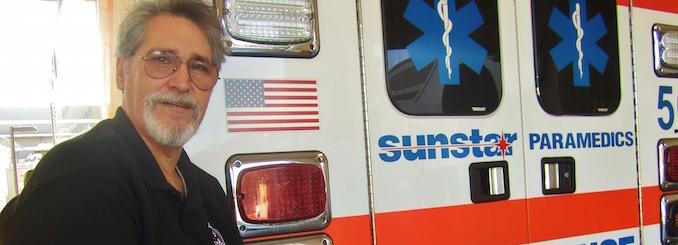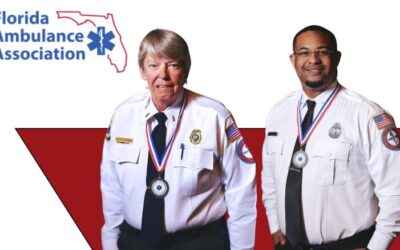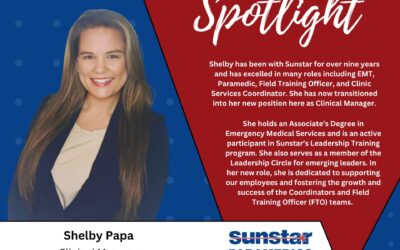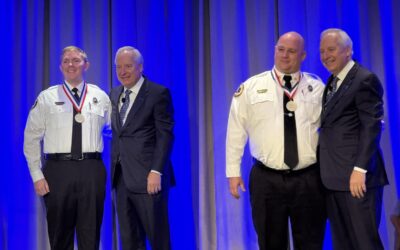Frank Farris may be one of the longest-serving emergency responders in Pinellas County. He started his career in 1973 as an EMT for Florida Ambulance, one of three ambulance providers in Pinellas County at the time, and took the first statewide qualification exam to become a paramedic in 1975.
“I began volunteering with emergency response teams in my hometown as a teenager and knew I wanted to spend my life helping others,” said Farris. “The job is stressful, but the satisfaction of saving a life makes it worthwhile.”
Farris dedicated his 42-year career to public service and plans to retire from Sunstar Paramedics in the near future. He’s seen changes in almost every aspect of emergency response, from ambulance and equipment design to assessment protocols and treatment techniques.
The first ambulance that Farris used was a converted Chevy Suburban with a fiberglass high top installed on the back to make room for the patient and equipment. The back was very small, even with the added height, so the patient and first responder sat arm to arm.
“Sitting in such close proximity to the patient forced me, and other new recruits, to quickly become comfortable with patient contact,” said Farris. “It also showed me the importance of having empathy for a patient.”
 At that time, the EMS team would stabilize the patient on the scene and complete as much medical care as possible in the ambulance during transport. Over the years, ambulances evolved into modified vans, then the module vehicles used today.
At that time, the EMS team would stabilize the patient on the scene and complete as much medical care as possible in the ambulance during transport. Over the years, ambulances evolved into modified vans, then the module vehicles used today.
When Farris started working in EMS, getting to the scene could be difficult. Emergency response crews navigated Pinellas County roads using maps and memory. They were expected to knowing how to navigate the entire county, not just their normal response area. It was a lesson Farris quickly learned, and never forgot.
“I was based in south Pinellas and filling in for a crew member in Tarpon Springs when I got lost in its winding bayous while responding to a call,” said Farris. “My mentor Barry Mogil made it very clear that getting lost anywhere in the county was unacceptable and I would undergo navigation testing in one week. I drove all over Pinellas County during my time off that week to prepare for his test. And I passed with flying colors.”
In the 1980s, EMS crews received grid maps, bound into 150-page books, to help with directions in the ambulance. Now crews have the help of dispatchers using GPS to guide them on the fastest route to an emergency scene.
GPS wasn’t the only tool that emergency responders lacked in the 19070s. At that time, EMTs and paramedics had limited communication on the scene because radios were installed in the ambulance. A standard radio connected the crew with dispatch. The hospital emergency administration radio (HEAR) connected crews to hospitals around the state; it could be used to receive treatment advice while en route or notify a hospital they were bringing in a patient.
The medical equipment inside the ambulance received upgrades over the years. Early in Farris’ career, it was much heavier than today. The oscilloscope, which creates and prints the electrocardiogram test (EKG), and the transmitter, which sends the EKG to the hospital, used to weigh 28 to 40 pounds. The same piece of equipment weighs less than 12 pounds today.
Procedures and training programs have evolved to become standardized and more effective over the years, and as a former training supervisor, Farris has helped the Sunstar team keep up with the changes.
He’s seen nearly every aspect of the profession change except one – the dedication and desire of EMTs and paramedics to serve their community. He’s trained thousands of Sunstar’s paramedics and EMTs. Farris believes nothing can replace hands-on experience when it comes to learning how to care for patients in an emergency. Four of his core rules for exceptional patient care are:
1. Put yourself in the patient’s position to fully understand how scared they are.
2. Always listen to the patient; they know their body better than you do.
3. Touch the patient’s skin to create a bond and provide reassurance. This lets you immediately take a pulse and gauge skin temperature to begin your diagnosis.
4. The second patient is the family. Your job is to help them stay calm and ease their fears.
These four tips are one part of Farris’ lasting legacy with Sunstar Paramedics. Nearly every Sunstar team member has spent time working with Farris or participated in one of his trainings. Sunstar Paramedics thanks Farris for his many contributions to the organization and to Pinellas County’s emergency services over the past 42 years.



